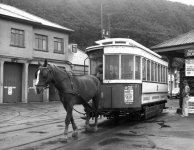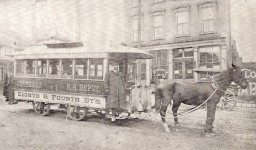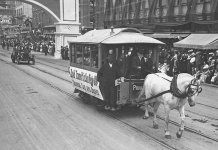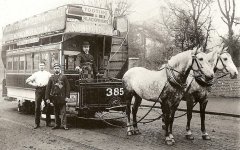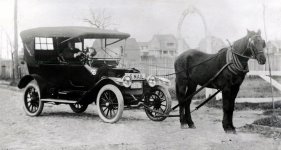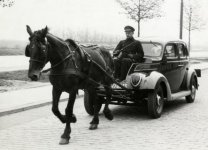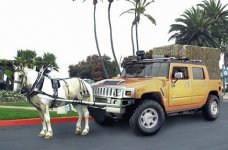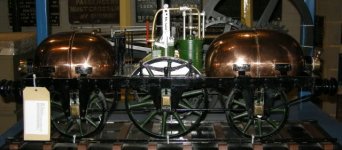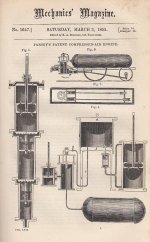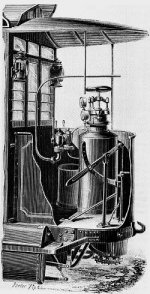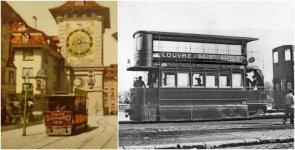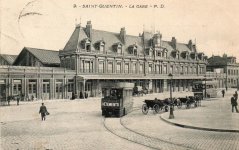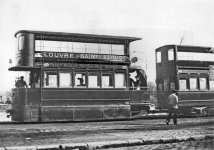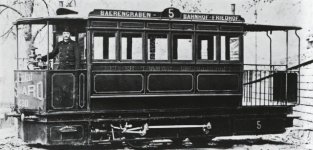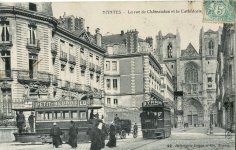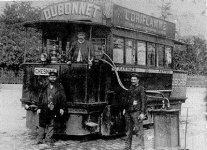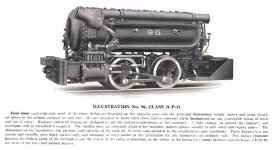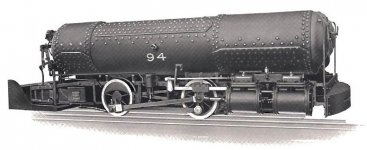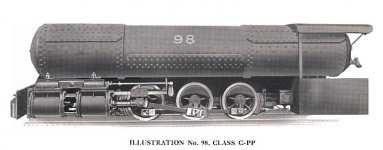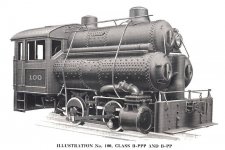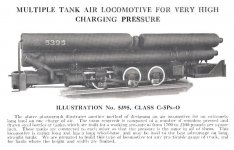For me it all started with this hard to explain streetcar setup, where a streetcar was being pulled by a horse. This is one of those instances where an official explanation was running into a sharp contradiction with common sense. I was always wondering why people would go through the hurdles of developing, producing and installing a whole rail system to just use it in a horsecar combination. This of course, had to include the development, and production of the actual car. Just like I mentioned, the rig became known as a horsecar.
Wikipedia contains its own explanation of this horsecar occurrence, "The horse-drawn tram (horsecar) was an early form of public rail transport that developed out of industrial haulage routes that had long been in existence, and from the omnibus routes that first ran on public streets in the 1820s, using the newly improved iron or steel rail or tramway."
The above sort of gibberish language and bogus explanation could never sit well with me. Common sense was suggesting that a normal person would never go the length required to produce the entire rail system to just pull cars with horses. Indeed, none of us would think that the below provided setups were intended to be used as presented.
So I naturally started to suspect that those 19th century rail systems, and railcars were developed due to some existing technology based propulsion system. Yet, I remember hearing somewhere that as technology progressed horse cars were replaced with cablecars and electric tramcars. Now and then I would run into images I had hard time explaining. The examples are below. Where are the horses? What powered these cars?

In the process of my research I learned, that in the 19th century we had three additional modes of streetcar propulsion:


(Some alternate history researchers suggest that there could have been atmospheric electricity powered streetcars, but I'm yet to find any concrete proof.)
Now, we should definitely ask questions about what kind of battery was powerful enough to push a streetcar forward in the 19th century. The electric battery, for sure, would make a fun target for some future investigation.
Additionally, as far as 19th century steam streetcars go... what fuel did they use? Coal or wood is out of the equation in the above type of the steam streetcars.

Obviously we have this "Industrial Revolution" happening. All of a sudden the mankind got so smart, that inventions were coming in by the thousands. It is even more bizarre when you consider that pneumatic engine ideas were supposedly getting developed as early as 1687. Yup, Denis Papin apparently came up with the idea of using compressed air in the 17th century. In 1687, Papin unveiled a new invention to transmit power pneumatically, in order to develop a means of spreading industrialization to areas where water power was not available. This idea was hotly opposed in the Royal Society, and Papin left England to accept a chair of mathematics at the University of Marburg in Hesse, bordering Hanover.

In 1690, Papin published an historic article in the Acta Eruditorum of Leipsig, "A New Method of Obtaining Very Great Moving Powers at Small Cost," where he proposed using the power of expanding steam to operate a piston/cylinder engine.
 Papin's answer to Leibniz (July 25,1698): "The method in which I now use fire to raise water rests always on the principle of the rarefaction of water. But I now use a much easier method than that which I published. And furthermore besides using suction, I also use the force of the pressure which water exerts on other bodies when it expands. These effects are not bounded, as in the case of suction. So I am convinced that this discovery if used in the proper fashion will be most useful .... For myself I believe that this invention can be used for many other things besides raising water. I've made a little model of a carriage which is moved forward by this force: And in my furnace it shows the expected result. But I think that the unevenness and bends in large roads will make the full use of this discovery very difficult for land vehicles; but in regard to travel by water I would flatter myself to reach this goal quickly enough if I could find more support than is now the case .... It gave me much joy to find that you also have some plans to put the moving force of fire to use, and I strongly hope that the little test you told me of succeeded to your satisfaction"
Papin's answer to Leibniz (July 25,1698): "The method in which I now use fire to raise water rests always on the principle of the rarefaction of water. But I now use a much easier method than that which I published. And furthermore besides using suction, I also use the force of the pressure which water exerts on other bodies when it expands. These effects are not bounded, as in the case of suction. So I am convinced that this discovery if used in the proper fashion will be most useful .... For myself I believe that this invention can be used for many other things besides raising water. I've made a little model of a carriage which is moved forward by this force: And in my furnace it shows the expected result. But I think that the unevenness and bends in large roads will make the full use of this discovery very difficult for land vehicles; but in regard to travel by water I would flatter myself to reach this goal quickly enough if I could find more support than is now the case .... It gave me much joy to find that you also have some plans to put the moving force of fire to use, and I strongly hope that the little test you told me of succeeded to your satisfaction"
About 1819, William Murdock and David Gordon are believed to have made some experiments with compressed-air carriages, apparently for road rather than rail, but nothing is known about the results. By 1821 David Gordon had attempted to set up a company to promote road locomotives propelled by a high pressure engine, or a gas vacuum engine, or a pneumatic engine supplied by what he called "portable gas". William Mann, of Brixton, turned his attention to the subject in 1827, obtained a patent in 1829, and published a pamphlet on the subject in 1830. He advocated compression in stages, now recognised as essential for the production of air at high pressures, and the erection of power stations along the high roads at intervals of 15 to 20 miles, or a continuous iron main with power stations in the coal districts.

In 1828 Bompas took out a patent for a compressed-air locomotive in England. There were two storage tanks between the frames, with conventional cylinders and cranks.

In the image below, "The first compressed-air carriage of which there is an authentic account was constructed by two Frenchmen, Andrund and Tessie du Motay, about 1840. As will be seen from the image it was made for running upon rails; it was adapted to carry eight passengers; had the air stored at a pressure of 17 atmospheres, while the working pressure in the cylinder was three atmospheres. These inventors also contemplated the application of compressed air to road carriages; they proposed to use pressures as high as 60 atmospheres, which were to be attained in stages, and to heat the air before its admission to the cylinder. They were the first to indicate the necessity of a reserve supply of air for use in hill-climbing or for other contingencies when the pressure in the main reservoirs was approaching its lower limit."

In 1844 M. Andraud built a 2-2-2 locomotive weighing five tons, with a single rivetted air tank holding 106 cubic feet of air at 300 psi. It was first tested on Saturday 21st September 1844 on the Versailles Left Bank track where it covered a two mile return journey at a speed of between 17 and 20 mph. A 1841 patent reveals that Andraud and Tessie du Motay were based at No 35, Rue Chabrol, in Paris; this road still exists and lies to the south-west of the Gare du Nord, where channel tunnel trains from Great Britain terminate.
This image below comes from the Encyclopedia Catholique, which gives these details: the capacity of the tank was between 8 and 10 cubic metres, pressurised to 20 atmospheres. (293 psi) The pressure agrees with the value given above, but 8 cubic metres is 282 cubic feet, almost three times as much. It appears that the cylinders were inside the frames at the rear, driving the middle axle. The Encyclopedia states that the locomotive was of "double effet"; this might mean either that the cylinders were double-acting, or that compound expansion was used. It was probably the former; if compound expansion really was used, it was 50 years ahead of Hodge and Porter. Encyclopedia Catholique, Parent-Desbarres, 1845

Arthur Parsey took out English patents for compressed-air locomotives in 1839, (No 8,093) 1844, and 1854. (No 88) He also took out a US patent (No 5,205) in 1847. The reservoir A was filled with air "compressed to as great an extent as was compatible with safety" which fed chamber D, kept at engine pressure by an automatic reducing valve C. A pipe fed the double-acting steeple engine B. At F is the air recharge valve, and G is the safety valve. The locomotive was intended for coal-mine work, but it is not clear if it was actually built. The engine appears to have a single cylinder, which must have given dead-center problems.
 This Parsey model is in the York Railway Museum in England. They say it was constructed in 1845.
This Parsey model is in the York Railway Museum in England. They say it was constructed in 1845.
In the summer of 1868, New Orleans inventor named Charles Wailey, began to test his prototype streetcar powered by compressed air. At 2:30 in the afternoon one day that July, 40 men piled into a car at Tchoupitoulas Street and Jackson Avenue, and off they went.

"The car used was an unwieldy concern," wrote the New Orleans Times on July 10, "and the air chambers, twelve feet long and fifteen inches in diameter, were made of boiler iron and are said to weigh over 1,500 pounds. The rest of the machinery is neither heavy nor complicated, and was found to be completely under control. With a pressure of but 84 lbs. to the square inch instead of 300, which was considered necessary by Capt. Whaley (Ed: the local press could not agree on the spelling of his name, par for the course at the time), the inventor, the car moved with all the requisite velocity." - source
In 1872 the Mekarski air engine was used for street transit, consisting of a single stage engine. It represented an extremely important advance in terms of pneumatic engines, due to its forward thinking use of thermodynamics, ensuring that the air was heated, by passing it through tanks of boiling water, also increasing its range between fill-ups. Numerous locomotives were manufactured and a number of regular lines were even opened up (the first in Nantes in 1879).
Additional information can be obtained in this article: The Mekarski system – compressed-air propulsion system for trams
In 1914 the H K Porter Company published the second edition of their book: Modern Compressed Air Locomotives.
Eventually this technology bled through into regular cars. Unfortunately we do not have much. Bits and pieces here and there is all that's available.
From The Horseless Age for October 1898: "In 1895, the Pneumatic Carriage Company was organized under the laws of West Virginia, with an authorized capital of $5,000,000, and with offices at 253 Broadway, New York. The organizers had been conducting experiments with compressed air motors for street railway service for several years, and naturally turned toward the motor vehicle when it received its first impetus in America. The president and manager of the company is A. H. Hoadley, who has been in charge of the experiments at the works of the American Wheelock Engine Company, Worcester, Mass.
The first carriage built by the company, illustrated herewith, was completed in November, 1896. It has seating accommodations for six passengers, weighs 2700 pounds, and will run 20 miles over ordinary good roads on one charge. A grade of 20 per cent is claimed to be surmountable. The wooden wheels are 30 and 42 inches respectively, and pneumatics of 4 inches diameter render riding as easy as possible. The motor, of the reciprocating type, weighs 400 pounds and operates at 350 revolutions, when the carriage is making 15 miles an hour. Ordinary compensating gear and hub steering are employed. In order to heat and expand the air before it enters the motor, it is surcharged with hot water, carried in the vehicle in a separate tank and kept at a temperature of 400 degrees Fahrenheit. Five pounds of water are required for each mile traversed. All the above machinery is spring-supported, to relieve it from the shocks of the road.
This carriage has been tested for the past year or more in the streets of Worcester and Washington, DC"

Then we have the below interesting AIRMOBILE. There is not much information about this image, just what these guys were able to accumulate. The historical record is rather vague, but it appears that by 1914 Harris and Goldman were preparing to produce a car that had four-wheel rotary air-brakes which also functioned as air-motors, and also two air storage cylinders and an engine-compressor combination.


In 1925, an article appeared in the Decatur Review about a man named Louis C. Kiser who converted his gasoline powered car to run on air. Lee Barton Williams in 1926 claimed to have invented the first air car. Williams was from Pittsburg and claimed the car started on gasoline but after 10 mph it switched to compressed air only.

The Roy J Meyers Compressed Air car of 1932. Of course Mr. Meyers was proclaimed a fraudster. Smart people stated that this vehicle will not function because it is based on a perpetual-motion, which we all know is impossible.

The Boyette Compressed-Air Railcar of 1934. The basic propulsion of this piece of eccentricity was by big tanks of compressed air. This one was ridiculed as well due to its perpetual drive.

It appears that any useful information was purged from public access long time ago. Why else would we have little random articles, like this 1897 example below?

KD: As long as air is free, this technology will stay suppressed. I have no doubt that it went away because certain individuals found more profits in charging this world for petrol. Of course they provided us with an explanation of why this Compressed Air mode is not suitable for today's society.
On a separate note, the question I have is where did this technology come from in first place? We have this bizarre disconnect between our educational reality where people use horses to pull their cars as late as 1926 for the U.S., and 1954 for the rest of the world. Yet, we simultaneously have street cars running on compressed air, at least, as early as 1828.
Wikipedia contains its own explanation of this horsecar occurrence, "The horse-drawn tram (horsecar) was an early form of public rail transport that developed out of industrial haulage routes that had long been in existence, and from the omnibus routes that first ran on public streets in the 1820s, using the newly improved iron or steel rail or tramway."
The above sort of gibberish language and bogus explanation could never sit well with me. Common sense was suggesting that a normal person would never go the length required to produce the entire rail system to just pull cars with horses. Indeed, none of us would think that the below provided setups were intended to be used as presented.
So I naturally started to suspect that those 19th century rail systems, and railcars were developed due to some existing technology based propulsion system. Yet, I remember hearing somewhere that as technology progressed horse cars were replaced with cablecars and electric tramcars. Now and then I would run into images I had hard time explaining. The examples are below. Where are the horses? What powered these cars?
In the process of my research I learned, that in the 19th century we had three additional modes of streetcar propulsion:
- electric battery powered
- compressed air powered
- steam powered (but not your typical locomotives)
(Some alternate history researchers suggest that there could have been atmospheric electricity powered streetcars, but I'm yet to find any concrete proof.)
Now, we should definitely ask questions about what kind of battery was powerful enough to push a streetcar forward in the 19th century. The electric battery, for sure, would make a fun target for some future investigation.
Additionally, as far as 19th century steam streetcars go... what fuel did they use? Coal or wood is out of the equation in the above type of the steam streetcars.
Compressed Air Power
This is actually some fun stuff folks. 150 years ago people were getting around by driving compressed air powered personal cars, and were boarding compressed air powered modes of public transportation. We are so duped into our internal combustion engines, that it is both sad and suspicious. Where did this compressed air technology come from?
About 1819, William Murdock and David Gordon are believed to have made some experiments with compressed-air carriages, apparently for road rather than rail, but nothing is known about the results. By 1821 David Gordon had attempted to set up a company to promote road locomotives propelled by a high pressure engine, or a gas vacuum engine, or a pneumatic engine supplied by what he called "portable gas". William Mann, of Brixton, turned his attention to the subject in 1827, obtained a patent in 1829, and published a pamphlet on the subject in 1830. He advocated compression in stages, now recognised as essential for the production of air at high pressures, and the erection of power stations along the high roads at intervals of 15 to 20 miles, or a continuous iron main with power stations in the coal districts.
In the image below, "The first compressed-air carriage of which there is an authentic account was constructed by two Frenchmen, Andrund and Tessie du Motay, about 1840. As will be seen from the image it was made for running upon rails; it was adapted to carry eight passengers; had the air stored at a pressure of 17 atmospheres, while the working pressure in the cylinder was three atmospheres. These inventors also contemplated the application of compressed air to road carriages; they proposed to use pressures as high as 60 atmospheres, which were to be attained in stages, and to heat the air before its admission to the cylinder. They were the first to indicate the necessity of a reserve supply of air for use in hill-climbing or for other contingencies when the pressure in the main reservoirs was approaching its lower limit."
In 1844 M. Andraud built a 2-2-2 locomotive weighing five tons, with a single rivetted air tank holding 106 cubic feet of air at 300 psi. It was first tested on Saturday 21st September 1844 on the Versailles Left Bank track where it covered a two mile return journey at a speed of between 17 and 20 mph. A 1841 patent reveals that Andraud and Tessie du Motay were based at No 35, Rue Chabrol, in Paris; this road still exists and lies to the south-west of the Gare du Nord, where channel tunnel trains from Great Britain terminate.
This image below comes from the Encyclopedia Catholique, which gives these details: the capacity of the tank was between 8 and 10 cubic metres, pressurised to 20 atmospheres. (293 psi) The pressure agrees with the value given above, but 8 cubic metres is 282 cubic feet, almost three times as much. It appears that the cylinders were inside the frames at the rear, driving the middle axle. The Encyclopedia states that the locomotive was of "double effet"; this might mean either that the cylinders were double-acting, or that compound expansion was used. It was probably the former; if compound expansion really was used, it was 50 years ahead of Hodge and Porter. Encyclopedia Catholique, Parent-Desbarres, 1845
Arthur Parsey took out English patents for compressed-air locomotives in 1839, (No 8,093) 1844, and 1854. (No 88) He also took out a US patent (No 5,205) in 1847. The reservoir A was filled with air "compressed to as great an extent as was compatible with safety" which fed chamber D, kept at engine pressure by an automatic reducing valve C. A pipe fed the double-acting steeple engine B. At F is the air recharge valve, and G is the safety valve. The locomotive was intended for coal-mine work, but it is not clear if it was actually built. The engine appears to have a single cylinder, which must have given dead-center problems.
In the summer of 1868, New Orleans inventor named Charles Wailey, began to test his prototype streetcar powered by compressed air. At 2:30 in the afternoon one day that July, 40 men piled into a car at Tchoupitoulas Street and Jackson Avenue, and off they went.
Mekarski Compressed Air System
One way or the other, we were prone to end up talking about Louis Mekarski and his system of compressed-air powered trams. I personally think there was a whole bunch of other ones out there, but this one we have the most information on. Louis Mekarski was a Polish engineer and inventor living in France.In 1872 the Mekarski air engine was used for street transit, consisting of a single stage engine. It represented an extremely important advance in terms of pneumatic engines, due to its forward thinking use of thermodynamics, ensuring that the air was heated, by passing it through tanks of boiling water, also increasing its range between fill-ups. Numerous locomotives were manufactured and a number of regular lines were even opened up (the first in Nantes in 1879).
Additional information can be obtained in this article: The Mekarski system – compressed-air propulsion system for trams
In 1914 the H K Porter Company published the second edition of their book: Modern Compressed Air Locomotives.
Eventually this technology bled through into regular cars. Unfortunately we do not have much. Bits and pieces here and there is all that's available.
From The Horseless Age for October 1898: "In 1895, the Pneumatic Carriage Company was organized under the laws of West Virginia, with an authorized capital of $5,000,000, and with offices at 253 Broadway, New York. The organizers had been conducting experiments with compressed air motors for street railway service for several years, and naturally turned toward the motor vehicle when it received its first impetus in America. The president and manager of the company is A. H. Hoadley, who has been in charge of the experiments at the works of the American Wheelock Engine Company, Worcester, Mass.
The first carriage built by the company, illustrated herewith, was completed in November, 1896. It has seating accommodations for six passengers, weighs 2700 pounds, and will run 20 miles over ordinary good roads on one charge. A grade of 20 per cent is claimed to be surmountable. The wooden wheels are 30 and 42 inches respectively, and pneumatics of 4 inches diameter render riding as easy as possible. The motor, of the reciprocating type, weighs 400 pounds and operates at 350 revolutions, when the carriage is making 15 miles an hour. Ordinary compensating gear and hub steering are employed. In order to heat and expand the air before it enters the motor, it is surcharged with hot water, carried in the vehicle in a separate tank and kept at a temperature of 400 degrees Fahrenheit. Five pounds of water are required for each mile traversed. All the above machinery is spring-supported, to relieve it from the shocks of the road.
This carriage has been tested for the past year or more in the streets of Worcester and Washington, DC"
Then we have the below interesting AIRMOBILE. There is not much information about this image, just what these guys were able to accumulate. The historical record is rather vague, but it appears that by 1914 Harris and Goldman were preparing to produce a car that had four-wheel rotary air-brakes which also functioned as air-motors, and also two air storage cylinders and an engine-compressor combination.
It appears that any useful information was purged from public access long time ago. Why else would we have little random articles, like this 1897 example below?
KD: As long as air is free, this technology will stay suppressed. I have no doubt that it went away because certain individuals found more profits in charging this world for petrol. Of course they provided us with an explanation of why this Compressed Air mode is not suitable for today's society.
On a separate note, the question I have is where did this technology come from in first place? We have this bizarre disconnect between our educational reality where people use horses to pull their cars as late as 1926 for the U.S., and 1954 for the rest of the world. Yet, we simultaneously have street cars running on compressed air, at least, as early as 1828.


